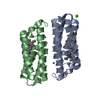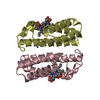+Search query
-Structure paper
| Title | Metal-directed, chemically tunable assembly of one-, two- and three-dimensional crystalline protein arrays. |
|---|---|
| Journal, issue, pages | Nat Chem, Vol. 4, Issue 5, Page 375-382, Year 2012 |
| Publish date | Mar 4, 2012 |
 Authors Authors | Jeffrey D Brodin / X I Ambroggio / Chunyan Tang / Kristin N Parent / Timothy S Baker / F Akif Tezcan /  |
| PubMed Abstract | Proteins represent the most sophisticated building blocks available to an organism and to the laboratory chemist. Yet, in contrast to nearly all other types of molecular building blocks, the designed ...Proteins represent the most sophisticated building blocks available to an organism and to the laboratory chemist. Yet, in contrast to nearly all other types of molecular building blocks, the designed self-assembly of proteins has largely been inaccessible because of the chemical and structural heterogeneity of protein surfaces. To circumvent the challenge of programming extensive non-covalent interactions to control protein self-assembly, we have previously exploited the directionality and strength of metal coordination interactions to guide the formation of closed, homoligomeric protein assemblies. Here, we extend this strategy to the generation of periodic protein arrays. We show that a monomeric protein with properly oriented coordination motifs on its surface can arrange, on metal binding, into one-dimensional nanotubes and two- or three-dimensional crystalline arrays with dimensions that collectively span nearly the entire nano- and micrometre scale. The assembly of these arrays is tuned predictably by external stimuli, such as metal concentration and pH. |
 External links External links |  Nat Chem / Nat Chem /  PubMed:22522257 / PubMed:22522257 /  PubMed Central PubMed Central |
| Methods | EM (helical sym.) / X-ray diffraction |
| Resolution | 2 - 10.0 Å |
| Structure data |  EMDB-5341:  PDB-3tol:  PDB-3tom: |
| Chemicals |  ChemComp-HEM:  ChemComp-ZN:  ChemComp-CA:  ChemComp-HOH: |
| Source |
|
 Keywords Keywords | METAL BINDING PROTEIN / four helix bundle / electron transfer / periplasmic space |
 Movie
Movie Controller
Controller Structure viewers
Structure viewers About Yorodumi Papers
About Yorodumi Papers




